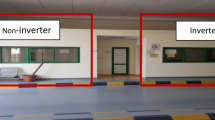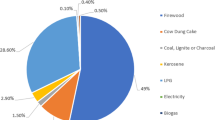Abstract
The hybrid system with radiant cooling and dedicated outdoor air not only possesses high energy efficiency, but also creates a healthy and comfortable indoor environment. Indoor air quality will be improved by the dedicated outdoor air system (DOAS) and indoor thermal comfort can be enhanced by the radiant cooling system (RCS). The optimal air-supply mode of the hybrid system and the corresponding design approach were investigated. A full-scale experimental chamber with various air outlets and the ceiling radiant cooling panels (CRCP) was designed and established. The performances of different air-supply modes along with CRCPs were analyzed by multi-index evaluations. Preliminary investigations were also conducted on the humidity stratification and the control effect of different airflow modes to prevent condensation on CRCP. The overhead supply air is recommended as the best combination mode for the hybrid system after comprehensive comparison of the experiment results. The optimal proportion of CRCP accounting for the total cooling capacities in accord with specific cooling loads is found, which may provide valuable reference for the design and operation of the hybrid system.
Similar content being viewed by others
References
LIU Wei-wei, LIAN Zhi-wei, RADERMACHER R, YAO Ye. Energy consumption analysis on a dedicated outdoor air system with rotary desiccant wheel [J]. Energy, 2007, 32(9): 1749–1760.
STETIU C. Energy and peak power savings potential of radiant cooling systems in US commercial buildings [J]. Energy and Buildings, 1999, 30(2): 127–138.
BEHNE M. Is there a risk of draft in rooms with cooling ceilings: measurement of air velocities and turbulences [J]. ASHRAE Transactions, 1995, 101(2): 744–746.
HODDER S G, LOVEDAY D L, PARSONS K C, TAKI A H. Thermal comfort in chilled ceiling and displacement ventilation environment: Vertical temperature asymmetry effects [J]. Energy and Buildings, 1998, 27(2): 167–173.
KITAGAWA K, KOMODA N, HAYANO H, TANABE S. Effect of humidity and small air movement on thermal comfort under a radiant cooling ceiling by subjective experiment [J]. Energy and Buildings, 1999, 30(2): 185–193.
LOVELY D L, PARSONS K C, TAKI A H, HODDER S G. Displacement ventilation environments with chilled ceiling: thermal comfort design within the context of BS EN ISO7730 versus adaptive debate [J]. Energy and Buildings, 2002, 34(6): 573–579.
NAGANO K, MOCHIDA T. Experiment on thermal environment design of ceiling radiant cooling for supine human subjects [J]. Building and Environment, 2004, 39(3): 267–275.
TIAN Zhen, LOVE J A. A field study of occupant thermal comfort and thermal environments with radiant slab cooling [J]. Building and Environment, 2008, 43(10): 1658–1670.
CATALINA T, VIRGONE J, KUZNIK F. Evaluation of thermal comfort using combined CFD and experimentation study in a test room equipped with a cooling ceiling [J]. Building and Environment, 2009, 44(8): 1740–1750.
EN 14240-2004. Ventilation for buildings-chilled ceilings-testing and rating [S]. Brussels: European Committee for Standardization, 2004.
KRANTZ KOMPONENTEN. Cooling and heating systems-static cooling ceiling system SKS-4/3 [R]. Aachen: Krantz Komponenten, 2007.
ANSI/ASHRAE Standard 55-2004. Thermal environment conditions for human occupancy [S]. Atlanta: American Society of Heating Refrigerating and Air-Conditioning Engineers Inc., 1992.
ISO, International standard 7730. Moderate thermal environments: determination of the PMV and PPD indices and specification of the conditions for thermal comfort [S]. Geneva: International Organization for Standardization, 2005.
JEONG J W, MUMMA S A. Ceiling radiant cooling panel capacity enhanced by mixed convection in mechanically ventilated spaces [J]. Applied Thermal Engineering, 2003, 23: 2293–2306.
JEONG J W, MUMMA S A. Simplified cooling panel capacity estimation model for top insulated metal ceiling radiant cooling panels [J]. Applied Thermal Engineering, 2004, 24(14/15): 2055–2072.
JEONG J W, MUMMA S A. Practical cooling capacity estimation model for a suspended metal ceiling radiant cooling panel [J]. Building and Environment, 2007, 42(9): 3176–3185.
TIAN Zhe, YIN Xing-lei, DING Yan, ZHANG Cheng. Research on the actual cooling performance of ceiling radiant panel [J]. Energy and Buildings, 2012, 47(4): 636–642.
Author information
Authors and Affiliations
Corresponding author
Additional information
Foundation item: Project(51178298) supported by the National Natural Science Foundation of China
Rights and permissions
About this article
Cite this article
Ding, Y., Tian, Z. & Zhu, N. Optimal air-supply mode of hybrid system with radiant cooling and dedicated outdoor air. J. Cent. South Univ. 22, 735–746 (2015). https://doi.org/10.1007/s11771-015-2577-8
Received:
Accepted:
Published:
Issue Date:
DOI: https://doi.org/10.1007/s11771-015-2577-8




